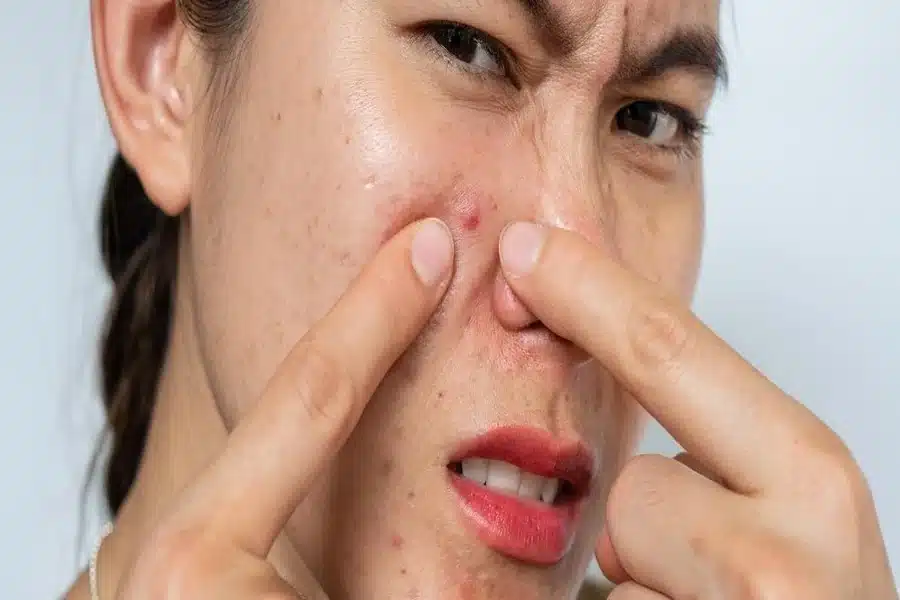How to Control Excess Sebum During Monsoon Season

Oily skin tends to become even oilier during the monsoon season. With increased humidity in the air, your skin’s sebaceous glands go into overdrive—producing more sebum than usual. The result? Greasy skin, enlarged pores, blackheads, clogged pores, and more frequent acne breakouts.
But the solution isn’t to strip your skin dry. In fact, over-cleansing or avoiding moisturizers can worsen oiliness. The key is to balance oil and hydration by using gentle, lightweight, and oil-regulating skincare—especially products containing ingredients like niacinamide serum and niacinamide moisturizer.
Let’s break down exactly how to control excess sebum in the rainy season without irritating or dehydrating your skin.
Why Sebum Increases in Monsoon
Monsoon brings with it high levels of atmospheric moisture. That means more sweat and less evaporation, which leaves your skin feeling sticky, greasy, and out of balance.
Here’s why oily skin feels worse during monsoon:
- Humidity increases sweat production
- Dirt and pollutants mix with sweat and oil, clogging pores
- Oil glands react to surface moisture by producing even more sebum
- Skin feels shiny and greasy, especially around the T-zone
The ideal skincare routine for monsoon focuses on oil regulation, lightweight hydration, and gentle exfoliation.
1. Start with a Gentle, Non-Stripping Cleanser
The first step to managing sebum is cleansing—but not harshly. Cleansing too often or using strong foaming agents can dry out your skin, triggering more oil production.
Look for a gentle cleanser that:
- Is sulfate-free
- Removes oil, sweat, and impurities
- Helps clear out pores without disrupting your skin barrier
Ingredients like salicylic acid or tea tree oil are helpful for oily skin. They combat acne-causing bacteria and help reduce oil, without over-drying. Avoid physical scrubs or harsh exfoliants—they often irritate the skin and can worsen oiliness in the long run.
2. Incorporate a Niacinamide Serum
One of the most effective solutions for oily skin is a niacinamide serum. Also known as Vitamin B3, niacinamide is a water-soluble vitamin that works with your skin’s natural processes to improve texture and reduce oiliness.
Benefits of using a niacinamide serum:
- Regulates sebum (oil) production
- Visibly minimizes pores
- Reduces redness, irritation, and inflammation
- Improves uneven texture and skin clarity
- Strengthens the skin’s natural barrier
Apply it after cleansing and before your moisturizer. Use it consistently, morning and evening, for visible improvement in oil balance and skin texture.
3. Don’t Skip Moisturizer—Use a Niacinamide-Based One
One of the biggest myths is that oily skin doesn’t need moisturizing—especially in humid weather. But skipping moisturizer actually leads to increased oiliness as your skin tries to rehydrate itself by producing more oil.
What you need is a niacinamide moisturizer that hydrates while also regulating oil production.
Choose a niacinamide moisturizer that is:
- Gel-based or water-light
- Oil-free and non-comedogenic
- Packed with niacinamide for pore and sebum control
- Absorbs quickly without leaving residue or shine
This kind of moisturizer supports a healthy skin barrier, helps reduce shine, and keeps your skin balanced even in sticky monsoon weather.
4. Exfoliate Smartly
Humidity can lead to a buildup of dead skin cells and oil on the skin’s surface. That’s why gentle exfoliation is important—but overdoing it can backfire.
Use a chemical exfoliant (like salicylic acid, a BHA) once or twice a week. BHAs work by penetrating deep into pores to:
- Clear out excess sebum
- Dissolve dead skin cells
- Reduce breakouts
- Prevent blackheads and whiteheads
Avoid physical scrubs or exfoliants with large granules, as they can damage the skin’s surface and lead to irritation or rebound oiliness.
5. Keep It Light and Oil-Free
When the weather is already humid, heavy products will only add to your skin’s burden. Keep your entire skincare routine light and breathable.
Smart product tips:
- Choose oil-free makeup and sunscreen
- Avoid thick creams or occlusive formulas
- Stick to gel-based or water-based skincare
- Use blotting papers or oil-control powders if shine appears mid-day
Light layering of products (cleanser → niacinamide serum → niacinamide moisturizer → sunscreen) is better than piling on thick, rich formulas that can clog pores.
6. Be Consistent and Give Products Time
One of the most overlooked aspects of oily skin management—especially in monsoon—is consistency. Skincare products like a niacinamide serum or niacinamide moisturizer don’t deliver overnight miracles. It takes at least 2–4 weeks of regular use to start seeing visible changes in oil control, pore size, and overall skin texture. Stick to your routine even when you don’t see immediate results. Avoid constantly switching products, as this can confuse your skin and lead to more breakouts or sensitivity. Choose what works—and give it time to work well.
Final Thoughts
Controlling excess sebum during the monsoon isn’t about stripping the skin or avoiding hydration. Instead, it’s about achieving a healthy oil-water balance by choosing the right ingredients and following a consistent routine.
A niacinamide serum helps manage oil and reduce pore visibility, while a niacinamide moisturizer keeps your skin hydrated without making it greasy. Paired with proper cleansing and occasional exfoliation, these products can help you keep your skin calm, clear, and shine-free—no matter how humid it gets outside.
Be patient, stay consistent, and keep your routine simple yet effective. Your skin will stay balanced and breakout-free, rain or shine.
